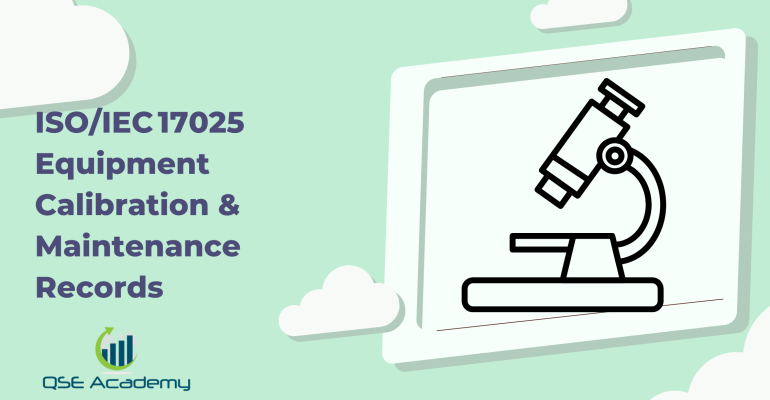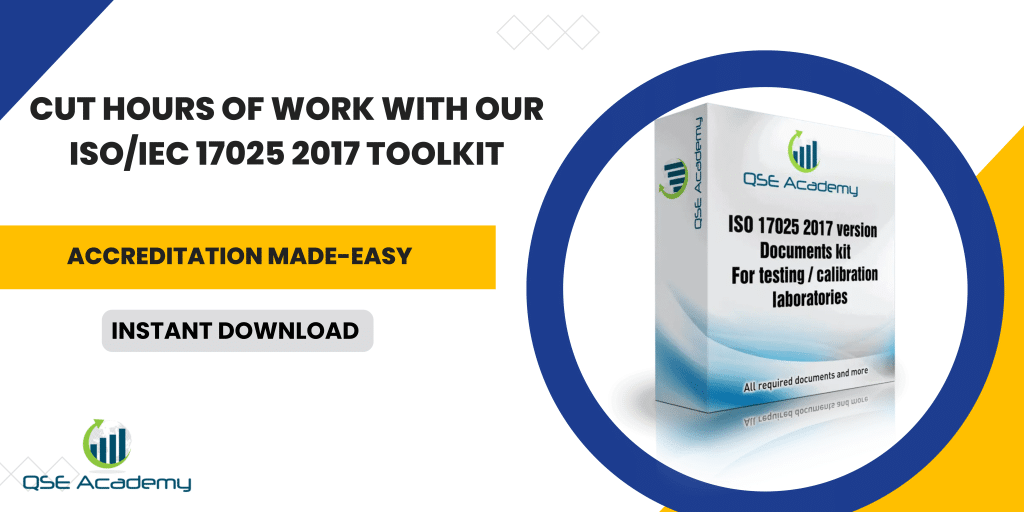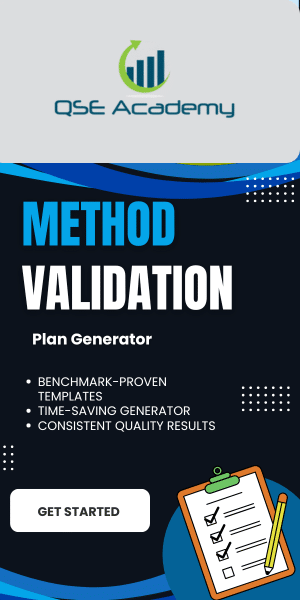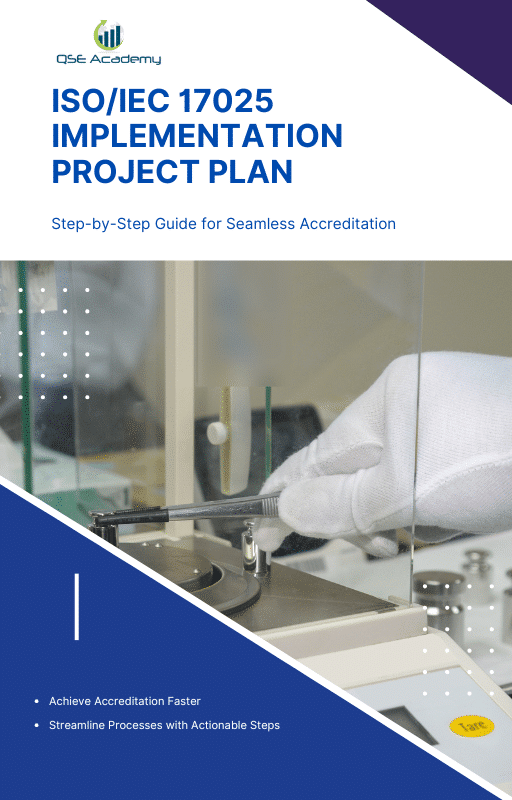ISO/IEC 17025 Equipment Calibration & Maintenance Records
Last Updated on October 13, 2025 by Melissa Lazaro
Why Calibration & Maintenance Records Make or Break ISO/IEC 17025 Compliance
If there’s one area that consistently catches labs off guard during an ISO/IEC 17025 audit, it’s equipment control.
Not because labs don’t calibrate their instruments — most do — but because they can’t prove it clearly on paper.
I’ve lost count of how many times I’ve heard,
“Oh, that instrument was calibrated last month — the certificate’s somewhere in the technician’s folder.”
That “somewhere” is exactly what auditors zero in on.
Here’s the truth: under ISO/IEC 17025, calibration and maintenance records aren’t optional housekeeping — they’re proof of competence. Your entire test or calibration result depends on the reliability of your equipment. If your records can’t show traceability, accuracy, and control, then your data can’t be trusted, period.
The good news? Setting this up doesn’t need to be complicated.
With a clear structure, consistent documentation, and a simple tracking method, your equipment records can go from audit risk to audit strength.
In this article, I’ll walk you through:
-
What ISO/IEC 17025 actually requires under Clause 6.4 (Equipment)
-
What your calibration and maintenance records must contain
-
How to build a simple, audit-friendly equipment log
-
Pro tips for preventing the most common nonconformities
By the end, you’ll have a complete roadmap for keeping your lab’s equipment calibration and maintenance records airtight — without drowning in paperwork.
Now, let’s break down what ISO/IEC 17025 really expects when it comes to equipment control.
Understanding ISO/IEC 17025 Requirements for Equipment Control
Before we dive into templates and records, let’s make sure we’re clear on what ISO/IEC 17025 actually expects. Because here’s what I’ve noticed — many labs think “equipment control” just means keeping calibration certificates. It’s much more than that.
Clause 6.4 – Equipment is one of the most practical parts of the standard. It’s not written for bureaucracy; it’s written for traceability and confidence. The whole idea is simple:
You can only trust your test or calibration results if the equipment you used is itself traceable, controlled, and maintained.
That’s it. That’s the backbone of this clause.
What ISO/IEC 17025 Means by “Equipment”
When auditors say “equipment,” they don’t just mean big instruments or fancy analyzers.
They mean everything that affects your results — including:
-
Reference standards and reference materials
-
Measuring devices (balances, thermometers, timers, pH meters, etc.)
-
Environmental monitors (temperature, humidity sensors)
-
Software and digital systems that process or calculate data
Basically, if it influences your measurement, it falls under Clause 6.4.
What Auditors Expect to See
An auditor’s first question is almost always the same:
“Show me how you know this equipment was fit for use when you used it.”
That means they’re looking for clear, complete documentation of:
-
Calibration status (traceable to national or international standards)
-
Maintenance and service records
-
Identification (unique equipment IDs or labels)
-
Usage history and condition
If any of those are missing, it’s a red flag.
Pro Tip:
Treat your equipment like “evidence generators.” Every piece of data that leaves your lab is only as good as the device that produced it — and the records that back it up.
Common Pitfalls Labs Make
-
Only keeping certificates but not internal maintenance logs.
-
Forgetting to label equipment with status or next calibration date.
-
Not documenting failed or repaired equipment.
-
Mixing accredited and non-accredited calibration providers without justification.
These seem small, but they add up quickly in an audit.
The Core of Compliance: What Calibration & Maintenance Records Must Include
Here’s where most labs either shine… or stumble.
Everyone has calibration certificates — but ISO/IEC 17025 compliance goes beyond that. Auditors don’t just want to see you calibrated your instruments; they want to follow the story of each piece of equipment — from purchase to daily use, from calibration to maintenance, all the way to disposal.
Your calibration and maintenance records are that story.
Let’s break down exactly what those records should include — and why each piece matters.
1. Equipment Identification
Every piece of equipment must have a unique identity.
Not just a name — a clear ID number that ties it to all records, certificates, and logs.
Include:
-
Equipment name and description
-
Model and serial number
-
Unique lab-assigned ID (like EQ-001 or BAL-2025-03)
-
Location or department where it’s used
Pro Tip:
Create a single “Equipment Master List” so anyone — auditor, manager, or technician — can find equipment details instantly.
2. Calibration Details
This is the heart of your record.
For each calibration, include:
-
Calibration date and next due date
-
Calibration method or reference procedure
-
Calibration provider (include accreditation details)
-
Reference standards used and their traceability
-
Results or adjustments made (if applicable)
Pro Tip:
Attach the calibration certificate directly to the equipment record. Don’t file it separately — auditors need to trace it in one click or one flip of a binder page.
3. Results & Adjustments
You don’t need to list every reading, but you do need to note:
-
Whether the equipment met tolerance
-
Any adjustments or repairs made
-
Actions taken if it failed
Example:
“2025-03-15 – Balance EQ-002 failed drift test. Adjusted and reverified. Results within tolerance.”
That’s all an auditor needs to see control and follow-up.
4. Maintenance Activities
ISO/IEC 17025 also expects you to keep maintenance logs, not just calibration ones.
That means documenting:
-
Preventive maintenance (cleaning, lubrication, firmware updates)
-
Corrective maintenance (repairs, part replacements)
-
Service provider details, if outsourced
Pro Tip:
Combine calibration and maintenance history in one continuous log. It tells a full story and avoids duplication.
5. Responsibility & Authorization
Every entry should show who did what — the technician performing the calibration or maintenance, and who reviewed or approved it.
It’s a small detail, but missing names or initials are one of the easiest nonconformities to spot.
6. Next Due Date and Equipment Status
This is where traceability meets control.
Every record must clearly show:
-
The next calibration due date
-
The current equipment status — “In Service,” “Under Maintenance,” or “Out of Calibration”
And yes, the same status must appear on the equipment label itself.
7. Supporting Attachments
Finally, link or attach:
-
Calibration certificates
-
Service reports
-
Traceability documents for reference standards
Common Mistake:
Labs often store these in different folders with different names — and panic during audits. Keep them together, even digitally, using consistent file names like:EQ-001_Calibration_2025-03-15_ABCMetrology.pdf
Building a Practical Equipment Calibration Log Template
Here’s the truth — your calibration and maintenance system is only as strong as your recordkeeping.
You can have the best calibration program in the world, but if your records are scattered across emails, certificates, and sticky notes, you’re setting yourself up for an audit headache.
That’s where a good Equipment Calibration Log comes in.
It’s not just a tracker — it’s your lab’s single source of truth for every piece of critical equipment.
What a Good Calibration Log Should Do
A proper log helps you:
-
Instantly see which equipment is due for calibration or maintenance
-
Prove traceability at a glance (no digging through folders)
-
Track the full history of each instrument, from purchase to retirement
-
Simplify audit preparation by keeping all data consistent and complete
Think of it as your audit safety net — because if an auditor points to an instrument and asks,
“Show me its calibration and maintenance history,”
you should be able to pull it up in seconds.
Here’s a Simple, Audit-Ready Layout
| Equipment ID | Description | Calibration Date | Calibrated By | Reference Standard / Provider | Results / Deviation | Next Due Date | Status | Remarks |
|---|---|---|---|---|---|---|---|---|
| EQ-001 | Analytical Balance | 2025-02-15 | ABC Metrology (ISO 17025 Accredited) | OIML Class E2 Weights | Within tolerance | 2026-02-15 | In Service | Verified after maintenance |
| EQ-002 | pH Meter | 2025-03-10 | Internal Calibration | NIST Buffer Solutions | Drift within 0.02 units | 2025-09-10 | In Service | Next service: replace electrode |
Pro Tip: Keep It Digital, But Structured
A spreadsheet or LIMS (Laboratory Information Management System) works great — if it’s well organized.
If you’re using Excel or Google Sheets, lock the structure, control editing access, and include a column for document links (like calibration certificates).
If you’re still on paper — no problem. Just make sure:
-
Each sheet has a version number and approval signature.
-
Equipment IDs match your physical labels.
-
You can show auditors the latest, active copy without confusion.
Pro Tip:
Color-code or flag overdue calibrations — green for active, yellow for due soon, red for overdue. Auditors love seeing proactive control.
Add a Maintenance Section or Log
Calibration is only half the story. Add a section to record preventive and corrective maintenance:
| Date | Maintenance Type | Performed By | Details | Next Due Date |
|---|---|---|---|---|
| 2025-02-01 | Preventive | Quality Tech A | Cleaned balance chamber, replaced desiccant | 2025-08-01 |
| 2025-04-20 | Corrective | ABC Service Co. | Replaced motor belt after vibration issue | 2026-04-20 |
Pro Tip:
Auditors love maintenance logs that show your lab doesn’t wait for problems — you prevent them.
Link Everything Together
Here’s how to make your system bulletproof:
-
Label every instrument with its ID and next due date.
-
Link every calibration certificate to the log entry.
-
Include the equipment in your master inventory list.
That’s full traceability — and that’s what ISO/IEC 17025 wants.
How to Plan, Schedule, and Track Equipment Calibration and Maintenance
Here’s something I’ve learned after years of helping labs prepare for accreditation:
The difference between a calm, confident audit and a stressful one often comes down to this question —
“When was that instrument last calibrated, and when is it due again?”
If your team has to dig through emails or chase down technicians to find the answer, your system isn’t working.
ISO/IEC 17025 expects you to have a planned, proactive calibration and maintenance schedule — not a reactive one.
Let’s talk about how to build one that actually works in real life.
Step 1: Identify Every Equipment That Affects Results
Start by listing all instruments and devices that influence the accuracy, precision, or validity of your results.
That includes:
-
Measuring instruments (balances, thermometers, pipettes)
-
Reference standards and reference materials
-
Software and monitoring devices
-
Environmental controls like ovens and incubators
Pro Tip:
If it affects your data, it belongs on the list — even if it’s “just” a timer or thermometer.
Step 2: Define Calibration and Maintenance Intervals
Don’t copy manufacturer recommendations blindly.
Set intervals based on risk, usage, and stability.
Ask yourself:
-
How critical is this instrument to my results?
-
How often is it used?
-
Has it stayed stable across previous calibrations?
Example:
A microbalance used daily for critical weighing might need calibration every 6 months.
A reference thermometer used only for verification checks might be fine annually.
Pro Tip:
Track trends. If a device consistently stays within tolerance, you can justify extending intervals.
If it drifts, shorten them.
Step 3: Build a Calibration and Maintenance Plan
Create a schedule that everyone can see — not hidden in someone’s folder.
This could be:
-
A spreadsheet with color-coded due dates
-
A wall calendar in the lab
-
A shared digital dashboard
Include:
-
Equipment ID
-
Calibration date
-
Next due date
-
Responsible person
Pro Tip:
Use reminders — calendar alerts, email notifications, or system-generated flags.
Auditors love seeing proactive monitoring.
Step 4: Track Compliance
A plan is useless if no one monitors it.
At least once a month, review the schedule and check:
-
What’s due next
-
What’s overdue
-
Whether all certificates are received and filed
When you catch issues early, you avoid explaining them later during an audit.
Real-World Example:
One calibration lab I worked with color-coded their Excel tracker — green for current, yellow for due soon, red for overdue.
When the assessor asked about overdue items, they had none. The sheet spoke for itself.
Step 5: Review and Adjust
Your plan isn’t fixed — it should evolve with your lab.
If equipment is added, replaced, or removed, update your list immediately.
After every management review, evaluate calibration performance and adjust intervals based on data trends.
Common Mistake:
Waiting until the audit to “update” your equipment list. By then, you’re not updating — you’re catching up.
Step 6: Link to Your Internal Audit Program
Finally, include calibration and maintenance checks in your internal audits.
This ensures someone verifies:
-
All records are up to date
-
Certificates are valid and traceable
-
Equipment labeling matches your log
Pro Tip:
Make it a standing checklist item — “All equipment calibrated, maintained, and labeled per schedule.”
Calibration Certificates: What to Keep and How to Read Them
Here’s something most labs learn the hard way:
Having a calibration certificate doesn’t automatically mean you’re compliant.
ISO/IEC 17025 isn’t just about having the document — it’s about proving that it’s valid, traceable, and relevant to your specific equipment and use case.
Let’s walk through what that means in practice.
1. What a Calibration Certificate Must Contain
Every calibration certificate — whether issued by an external provider or done in-house — must clearly show certain key details. Auditors expect to see all of the following:
-
Equipment Identification: model, serial number, and ID that matches your internal records
-
Calibration Date and Next Due Date (if specified by the lab or client)
-
Environmental Conditions during calibration (when relevant)
-
Reference Standards Used — including their calibration status and traceability
-
Measurement Results and Uncertainty Values
-
Statement of Conformity (pass/fail or within tolerance, if applicable)
-
Authorized Signatory and Accreditation Details
Pro Tip:
If you can’t match the equipment ID or serial number on the certificate to your internal log, that certificate is useless during an audit. Always double-check before filing.
2. How to Verify Calibration Traceability
Traceability is the golden word in ISO/IEC 17025.
It means that your measurement results can be linked — without interruption — to recognized national or international standards.
Here’s how to verify that traceability chain:
-
Make sure the calibration provider is ISO/IEC 17025-accredited, and the scope of accreditation covers the parameters calibrated.
-
Check that reference standards listed on the certificate are traceable to a national metrology institute (like NIST, PTB, or NPL).
-
Ensure that the uncertainty budget is clearly stated. Auditors will ask for it, especially if you perform your own calibrations.
Pro Tip:
Keep the provider’s accreditation certificate on file. Auditors may ask for it to verify the scope.
3. Organizing Calibration Certificates
Here’s a quick structure that makes life easier:
-
File each calibration certificate by equipment ID, not by supplier or date.
-
Use a consistent file naming convention like:
EQ-001_Calibration_2025-02-15_ABCMetrology.pdf -
Cross-link the certificate in your Calibration Log — that way, every record points directly to supporting evidence.
Pro Tip:
If you manage everything digitally, create a folder structure like this:/Equipment Records/Calibration/EQ-001/Certificates
That level of organization makes retrieval instant during an audit.
4. What to Do with Non-Accredited Calibration Providers
Sometimes, especially for specialized instruments, accredited providers aren’t available.
In that case, you can still use non-accredited calibration — but you must justify it.
Document:
-
Why no accredited provider was available
-
How you verified the provider’s technical competence
-
How traceability is maintained (e.g., by checking their reference standards)
Example:
“No ISO/IEC 17025-accredited provider available for dissolved oxygen meter calibration. Calibration performed by manufacturer with traceable standards verified by internal check.”
This shows due diligence, which auditors appreciate.
5. Common Mistakes with Calibration Certificates
-
Filing certificates without checking the scope of calibration
-
Accepting certificates without uncertainty statements
-
Not linking certificates to specific equipment records
-
Losing track of expired certificates
-
Assuming “OEM calibration” means “ISO 17025 traceable” (it doesn’t, unless stated)
Pro Tip:
During audits, always review the certificate before presenting it. Highlight or mark the traceability statement — it saves time and shows you know your system.
Handling Nonconforming Equipment and Repairs
No matter how well-organized your lab is, equipment problems are inevitable.
Balances drift. Sensors fail. Calibration results fall outside tolerance.
The real test of ISO/IEC 17025 compliance isn’t avoiding those issues — it’s how you handle and document them.
When something goes wrong, you need to prove that you caught it, controlled it, and prevented bad data from slipping through.
1. What “Nonconforming Equipment” Really Means
In ISO/IEC 17025 terms, nonconforming equipment refers to any device that:
-
Fails calibration or verification,
-
Shows signs of malfunction, drift, or damage,
-
Has expired calibration,
-
Or was used under conditions that could compromise results.
Example:
A thermometer used past its calibration due date? Nonconforming.
A balance that failed its internal check? Also nonconforming.
Pro Tip:
The moment you identify an issue, the equipment’s status must change — it can’t be “business as usual.”
2. Isolate and Label Immediately
Step one: control the equipment so it can’t be used until it’s fixed.
Actions to take:
-
Tag it “OUT OF SERVICE” or “UNDER INVESTIGATION.”
-
Move it to a clearly marked area or lock it out in your system.
-
Update your Equipment Log to reflect the status.
Pro Tip:
Use color-coded tags: green for in-service, yellow for due soon, red for out-of-service. It’s visual control that even an auditor will notice at a glance.
3. Record the Incident
Every instance of nonconformance should be logged.
Your Equipment Nonconformance Log should include:
-
Equipment ID and description
-
Date and nature of the issue
-
Who identified it
-
Description of the problem or failed result
-
Immediate action taken (e.g., removed from service)
-
Corrective or repair action planned
Example:
“EQ-005 Oven – failed temperature uniformity check on 2025-04-10.
Removed from service, recalibration scheduled. No test data affected since last verification.”
That’s how you turn a potential finding into evidence of control.
4. Evaluate the Impact
This is where many labs get caught.
If equipment was found out of tolerance or malfunctioning, you must evaluate whether previous test or calibration results were affected.
Ask:
-
Was the equipment used on customer jobs during the affected period?
-
How far out of tolerance was it?
-
Are results still valid within measurement uncertainty?
Document your evaluation — even if you conclude there was no impact. Auditors want to see that you considered it.
Pro Tip:
Use a simple form or memo titled “Impact Assessment – Nonconforming Equipment.” Keep it attached to the record.
5. Corrective Action and Verification
After repair or recalibration, don’t just return the equipment to service.
Verify that it’s now performing correctly.
That means:
-
Conducting a post-repair calibration or functional check
-
Reviewing the results
-
Updating the equipment’s calibration and maintenance history
-
Getting approval from the Technical Manager before use
Example:
“Temperature chamber recalibrated post-repair; deviations within tolerance. Returned to service 2025-05-12.”
6. Prevent Recurrence
Every equipment issue teaches you something.
Use these incidents to improve preventive maintenance schedules, tighten controls, or retrain staff.
Pro Tip:
During management review, summarize all nonconformance incidents and lessons learned. It shows continual improvement — a big plus for auditors.
7. Common Mistakes to Avoid
-
Continuing to use equipment that’s overdue or failed calibration.
-
Forgetting to assess impact on past data.
-
No clear tag or record of out-of-service status.
-
“Fixing” the equipment but not re-verifying it before use.
Maintaining an Equipment History File (Audit Favorite)
If you’ve ever seen an auditor’s face light up during an ISO/IEC 17025 assessment, it’s usually because someone handed them a clean, complete equipment history file.
This is the gold standard of traceability — your one-stop record that shows everything about a piece of equipment from the day it entered your lab until the day it’s retired.
Let’s walk through what it should include and how to maintain it without turning your filing system into chaos.
1. What an Equipment History File Is (and Why It Matters)
Think of this file as your equipment’s “biography.”
It tells the full story — what it is, where it’s been, how it’s performed, and what’s been done to keep it reliable.
ISO/IEC 17025 expects labs to maintain sufficient information to demonstrate that equipment is fit for use and traceable throughout its life cycle.
A good file gives you instant answers when auditors ask:
“When was this equipment purchased, last calibrated, or repaired?”
Pro Tip:
If you can answer that in under 30 seconds, your equipment control system is working perfectly.
2. What to Include in Each Equipment History File
Every file (digital or physical) should contain these essential documents, in order:
-
Equipment Information Sheet
-
ID number, model, serial number, and manufacturer
-
Date of acquisition, installation, and commissioning
-
Location or assigned department
-
Responsible personnel
-
-
Calibration Certificates
-
All past and current certificates, with traceability and uncertainty data
-
Provider accreditation details and scope verification
-
-
Maintenance and Service Records
-
Preventive and corrective maintenance logs
-
Repair reports and service provider details
-
-
Verification or Intermediate Check Records
-
Any between-calibration checks or performance verifications
-
-
Nonconformance and Impact Assessments
-
If the equipment ever failed, include the investigation and actions taken
-
-
Modifications or Upgrades
-
Firmware updates, software changes, or hardware replacements
-
-
Decommissioning Record
-
Disposal date, reason for retirement, and sign-off from management
-
3. Digital vs. Paper Files
Both are acceptable — the key is control and accessibility.
-
Digital systems (like LIMS or shared drives) allow faster searches, cross-linking, and backups.
-
Paper systems are fine, but make sure they’re clearly labeled, indexed, and protected from damage.
Pro Tip:
If digital, restrict editing access to authorized users only.
If paper, keep all documents in plastic sleeves or binders labeled by equipment ID (e.g., “EQ-001 – Analytical Balance”).
4. File Naming and Version Control
Consistency is your best friend.
Use a clear naming system — for example:EQ-001_EquipmentHistory_Rev03_2025-04-01.pdf
This way, you always know:
-
Which file is current
-
When it was last updated
-
Who approved it
Pro Tip:
Include a version history table at the back — one line per revision with date, change summary, and approver initials.
5. Keep It Simple — and Linked
You don’t need to duplicate everything. Instead, link related records:
-
Reference the calibration log for ongoing data.
-
Reference the maintenance checklist for service details.
-
Store supporting certificates in subfolders under the main equipment folder.
Example Folder Structure:
This makes it effortless to trace the entire lifecycle of any instrument — a huge win during audits.
6. Common Pitfalls to Avoid
-
Scattering records across multiple drives or personal folders.
-
Missing proof of decommissioned equipment (auditors will ask).
-
Forgetting to record small maintenance actions (“minor fix” isn’t minor when it affects reliability).
-
Having outdated copies with no revision control.
7. Why Auditors Love a Good History File
Because it answers every question they have before they even ask.
A complete history file shows that:
-
Your lab maintains full equipment traceability.
-
You have evidence of calibration, maintenance, and performance checks.
-
Your staff understand and follow your system consistently.
In short, it proves you’re running a controlled, mature management system.
FAQs: Calibration & Maintenance Recordkeeping Simplified
Even after you’ve built a strong system, a few practical questions tend to come up — especially when labs start managing more instruments or tightening up documentation before an audit.
Let’s clear up the most common ones so you can keep your system simple, compliant, and easy to manage.
1. How long should we keep calibration and maintenance records?
ISO/IEC 17025 doesn’t specify an exact retention period — it depends on your lab’s policy, customer requirements, or regulatory rules.
That said, a solid best practice is to keep records until at least the next calibration cycle plus one full audit cycle.
In most labs, that means a minimum of two to three years.
Pro Tip:
If results from a test or calibration might still be referenced in future (e.g., for legal or contractual reasons), keep those equipment records indefinitely. It’s better to archive than to regret deleting.
2. Do I need to calibrate equipment that’s only used for monitoring or indication (not direct measurement)?
Yes — if it influences your results.
For example:
-
A thermometer inside an incubator affects test conditions.
-
A timer affects heating or curing cycles.
-
A hygrometer helps you verify environmental control.
Even if they don’t directly generate measurement data, they still need to be checked for accuracy or verified periodically.
Pro Tip:
If a device is truly non-critical, label it as “For indication only” — and document the rationale for exclusion from calibration.
3. Can we perform calibrations in-house?
Absolutely — but you must prove competence, traceability, and control.
To do that, you’ll need:
-
Trained, authorized personnel
-
Documented calibration procedures
-
Reference standards with valid traceability to national or international standards
-
Evidence of measurement uncertainty estimation
Pro Tip:
Internal calibrations should look just as professional as external ones — full documentation, clear results, and traceability references.
4. What if our calibration provider doesn’t have ISO/IEC 17025 accreditation?
That’s fine only if you justify it.
You’ll need to document:
-
Why you chose that provider
-
Evidence of their technical competence (e.g., service reports, traceability data)
-
The risks considered and how you mitigated them
It’s not ideal — but ISO 17025 allows flexibility if you can demonstrate control and reasoning.
5. How often should equipment maintenance be performed?
There’s no one-size-fits-all answer. Maintenance frequency depends on:
-
Manufacturer recommendations
-
Usage intensity
-
Environmental conditions
-
Past performance data
The key is consistency. Define maintenance intervals in your Equipment Maintenance Procedure, then follow and document them.
Pro Tip:
Preventive maintenance is cheaper than corrective action — and auditors can tell when your system’s reactive instead of proactive.
6. What’s the easiest way to prove traceability during an audit?
Keep it visual and organized:
-
Use an Equipment List showing calibration dates and traceability links.
-
Attach calibration certificates that reference recognized standards (like NIST or PTB).
-
Maintain provider accreditation certificates in one place.
If an auditor says, “Show me the traceability for this balance,” you should be able to pull up the certificate and traceability statement in seconds — no rummaging required.
Building Confidence Through Controlled Equipment Records
If there’s one thing ISO/IEC 17025 teaches you, it’s that trust is built on traceability.
Your calibration and maintenance records aren’t just files for the auditor — they’re the foundation of your lab’s credibility.
Because here’s the truth: when your equipment is under control, everything else follows. Your results are defensible. Your staff feel confident. Your clients trust your data without hesitation.
In my experience working with hundreds of labs, the ones that pass audits effortlessly have one thing in common — they don’t treat recordkeeping as paperwork. They treat it as proof of reliability.
Key Takeaways
-
Every instrument that affects test results must be identified, calibrated, maintained, and traceable.
-
A good record includes who, when, what, and how — calibration details, maintenance actions, and verification results.
-
Keep everything organized and accessible: one equipment ID, one story, one place.
-
Track due dates proactively — never let an auditor find an expired sticker before you do.
-
Treat nonconformities transparently. The goal isn’t perfection; it’s control and evidence of continual improvement.
From Compliance to Confidence
An audit-ready system doesn’t just tick ISO boxes — it makes your operations smoother. You catch problems early, make informed decisions about intervals and replacements, and have total visibility into the health of your instruments.
That’s what quality looks like in practice.
Next Step: Simplify Your Documentation
If you’re ready to tighten your equipment control system without starting from scratch, QSE Academy has you covered.
Our ISO/IEC 17025 Equipment Calibration & Maintenance Record Template includes:
-
Ready-to-use calibration and maintenance logs
-
Traceability tracking sheets
-
Built-in nonconformance and verification forms
And if your lab needs something tailor-fit, our consultants can help you create a customized equipment control system — built specifically for your scope, size, and accreditation body requirements.
Because in the end, ISO 17025 compliance isn’t just about passing audits — it’s about proving, every single day, that your lab’s results can be trusted.
That’s the standard. And that’s what real quality looks like.
I hold a Master’s degree in Quality Management, and I’ve built my career specializing in the ISO/IEC 17000 series standards, including ISO/IEC 17025, ISO 15189, ISO/IEC 17020, and ISO/IEC 17065. My background includes hands-on experience in accreditation preparation, documentation development, and internal auditing for laboratories and certification bodies. I’ve worked closely with teams in testing, calibration, inspection, and medical laboratories, helping them achieve and maintain compliance with international accreditation requirements. I’ve also received professional training in internal audits for ISO/IEC 17025 and ISO 15189, with practical involvement in managing nonconformities, improving quality systems, and aligning operations with standard requirements. At QSE Academy, I contribute technical content that turns complex accreditation standards into practical, step-by-step guidance for labs and assessors around the world. I’m passionate about supporting quality-driven organizations and making the path to accreditation clear, structured, and achievable.












